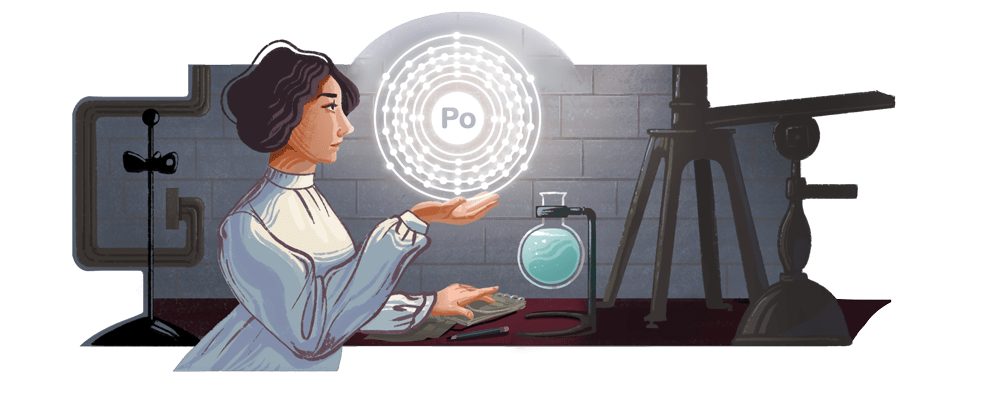Ștefania Mărăcineanu 140th Birthday : Google Doodle pays tribute to physicist Stefania Maracineanu
She was born in Bucharest, the daughter of Sebastian Mărăcineanu and Sevastia, both 20-years old. Not much is known about her personal life, only that she had an unhappy childhood. She completed high school at the Central School for Girls in her native city. In 1907 she enrolled at the University of Bucharest, receiving her degree in physical and chemical sciences in 1910. Her senior thesis, titled Light interference and its application to wavelength measurement, earned her a 300 lei prize. After graduation, she taught at high schools in Bucharest, Ploiești, Iași, and Câmpulung. In 1915, she secured a teaching position at the Central School for Girls in Bucharest, a position she held until 1940.
After World War I, with support from Constantin Kirițescu, Mărăcineanu obtained a fellowship that allowed her to travel to Paris to further her studies. In 1919 she took a course on radioactivity at the Sorbonne with Marie Curie. Afterwards, she pursued research with Curie at the Radium Institute until 1926. She received her Ph.D. from the Radium Institute; her thesis (which was published in 1924) was read at the French Academy’s session of June 23, 1923 by Georges Urbain.
At the Institute, Mărăcineanu researched the half-life of polonium and devised methods of measuring alpha decay. This work led her to believe that radioactive isotopes could be formed from atoms as a result of exposure to polonium’s alpha rays; an observation which would lead to the Joliot-Curies’ 1935 Nobel Prize. In 1935, Frederic and Irene Joliot-Curie (n.r. – daughter of scientists Pierre Curie and Marie Curie) won the Nobel Prize for the fantastic discovery of artificial radioactivity, although all data show that the Romanian was the first to make the revolutionary discovery.
In fact, Ștefania Mărăcineanu expressed her dismay at the fact that Irene Joliot-Curie had used a large part of her work observations regarding artificial radioactivity, without mentioning it. The Romanian woman publicly claimed that she discovered artificial radioactivity during her years of research in Paris, as evidenced by her doctoral dissertation, presented more than 10 years earlier. “Mărăcineanu wrote to Lisa Meitner in 1936, expressing his disappointment that Irene Joliot Curie, without her knowledge, used much of her work, especially that related to artificial radioactivity, in her work,” is mentioned in the book “A devotion to their science: Pioneer women of radioactivity ”. Mărăcineanu also investigated the possibility of sunlight inducing radioactivity; work which was contested by other researchers.
Nevertheless, a 1927 article from the Geraldton Guardian remarked: “Cheaper radium is foreshadowed in a communication to the French Academy of Sciences by a girl scientist, Mlle. Maricaneanu, who by means of lengthy laboratory experiments, has been able to demonstrate that lead exposed for a long time to the sun recovers its radioactive properties. The mechanism of this transformation is a complete mystery but it is regarded of such tremendous importance to medical science that further close research work is to be pursued.
Google Doodle pays tribute to physicist Stefania Maracineanu
Stefania Mărăcineanu was a pioneering woman in the field of radioactivity discovery and research. The Romanian physicist’s 140th birthday is commemorated in today’s Doodle.

Mărăcineanu earned a degree in physical and chemical science in 1910 and began her work as a teacher at Bucharest’s Central School for Girls. Mărăcineanu received a scholarship from the Romanian Ministry of Science while he was there. She chose to continue her studies at the Radium Institute in Paris as a graduate student.
Under the guidance of physicist Marie Curie, the Radium Institute swiftly became a global hub for the study of radioactivity. Mărăcineanu began work on her PhD thesis on polonium, a chemical element discovered by Curie.
Mărăcineanu found that the half-life of polonium seemed to be depending on the sort of metal it was placed on during her investigation. This made her worry if the polonium’s alpha particles had converted some of the metal’s atoms into radioactive isotopes. Her work resulted in the most likely first instance of artificial radioactivity.
Mărăcineanu enrolled at Paris’ Sorbonne University to complete her PhD in physics, which she completed in just two years! She returned to Romania after four years at the Astronomical Observatory in Meudon, where she established the country’s first laboratory for the research of radioactivity.
https //myinfo.kroger.com Login : How do I access my Kroger eSchedule?
Mărăcineanu devoted herself to artificial rain research, which included a journey to Algeria to test her findings. She also looked into the relationship between earthquakes and rainfall, and was the first to discover that the epicentre of an earthquake has a considerable increase in radioactivity in the days preceding up to an earthquake.
Irène Currie, Marie Curie’s daughter, and her husband were jointly awarded the Nobel Prize in 1935 for their discovery of artificial radioactivity. Mărăcineanu did not object to receiving the Nobel Prize, but she did request that her contribution to the discovery be acknowledged. Mărăcineanu’s work was recognised by the Romanian Academy of Sciences in 1936, when she was elected as a Director of Research, but she never garnered international acclaim for the discovery.
The original chemical laboratory in the Radium Institute, where Mărăcineanu worked, is now in the Curie Museum in Paris. Today’s Doodle celebrates the 140th birthday of Stefania Mărăcineanu and pays tribute to her legacy.
Be the first to comment